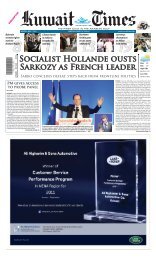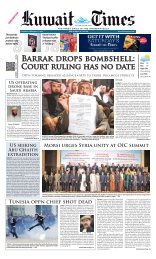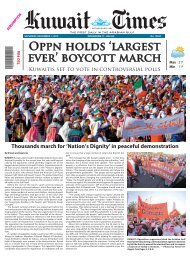Create successful ePaper yourself
Turn your PDF publications into a flip-book with our unique Google optimized e-Paper software.
FRIDAY, AUGUST 31, 2012<br />
BRASILIA: Brazil’s central bank cut its<br />
benchmark interest rate for the ninth<br />
straight time to a record low 7.5 percent,<br />
signaling that a year-long easing<br />
cycle may be over as the world’s No. 6<br />
economy starts to recover.<br />
The rate decision came hours after<br />
the government unveiled stimulus<br />
measures to boost consumption and<br />
investment, a move that shows that<br />
officials remains worried about the<br />
pace of recovery.<br />
The bank’s monetary policy board,<br />
known as Copom, unanimously decided<br />
to lower the so-called Selic rate by<br />
half a percentage point, as expected.<br />
However, the central bank hinted in<br />
its post-decision statement that an<br />
extra rate cut may not be needed, or it<br />
could be smaller.<br />
“The Copom considers that, if<br />
future conditions were to allow for an<br />
additional adjustment of monetary<br />
conditions, that movement should be<br />
conducted with maximum parsimony,”<br />
the bank said in the statement. It<br />
is the first time the central bank has<br />
clearly signaled in a post-decision<br />
statement that it might end the easing<br />
cycle that began in August 2011.<br />
After a year of aggressive rate cuts<br />
and more than a dozen government<br />
stimulus packages the Brazilian economy<br />
is finally showing some signs of<br />
life. Even with that massive stimulus,<br />
the Brazilian economy is seen growing<br />
less than 2 percent this year, much<br />
slower than the growth pace of its<br />
major emerging-market peers.<br />
The prospect of a stronger recovery<br />
in the second half has stoked fears<br />
of inflation becoming a problem next<br />
year after a jump in global food prices<br />
reversed the downward trend of 12-<br />
month inflation in July and mid-<br />
August. Higher annual inflation, which<br />
at 5.37 percent is slightly above the<br />
official target midpoint of 4.5 percent,<br />
could add pressure on the central<br />
bank to end the rate-cutting cycle.<br />
“The easing cycle may have ended<br />
today, but the Copom is not altogether<br />
closing the door to a potential one<br />
last iteration in this cycle, which if it<br />
takes will be within the confines dictated<br />
by ‘maximum parsimony,’”<br />
Alberto Ramos, chief Latin American<br />
economist with Goldman Sachs, said<br />
in a note. In the past, the central bank<br />
used the word parsimony to communicate<br />
to markets it planned to reduce<br />
the size of future rate cuts.<br />
The central bank has hinted before<br />
in meeting minutes it was near the<br />
end of its easing cycle, only to dismiss<br />
its own guidelines as the recovery<br />
Business<br />
Brazil cuts rate, hints easing cycle may be over<br />
MANILA: Workers are seen at a construction site in<br />
Manila yesterday. The Philippines said yesterday the<br />
economy grew a better-than-forecast 5.9 percent in the<br />
three months to June, largely due to a strong services<br />
sector. — AFP<br />
Philippine economy<br />
grows 5.9% in Q2<br />
MANILA: The Philippines economy grew a better-thanexpected<br />
5.9 percent in the second quarter, boosted by<br />
increased investment and a drive against corruption, the<br />
government said yesterday.<br />
The strong figure for April-June helped the country<br />
achieve 6.1 percent growth in the first half, with officials<br />
confident the good times would be sustained for the rest<br />
of the year. Socio-economic Planning Secretary Arsenio<br />
Balisacan credited President Benigno Aquino’s anti-corruption<br />
reforms for part of the growth, saying they had boosted<br />
the confidence of local and foreign investors.<br />
“We obviously would not have achieved (this growth)<br />
without the substantial improvement in the way people<br />
perceive the government... and the way we do business,”<br />
Balisacan told reporters.<br />
The economy grew a better-than-expected 6.3 percent<br />
in the January-March quarter, the government said,<br />
revised slightly up from an earlier estimate of 6.4 percent.<br />
Balisacan expressed confidence the momentum would<br />
continue, with 2012 growth settling at the “upper end” of<br />
the government’s target range of 5.0 to 6.0 percent.<br />
The second quarter gross domestic product (GDP) figure<br />
exceeded the 5.4-5.8 percent forecasts of independent<br />
analysts. Financial institutions also widely tipped growth<br />
to range from 4.8 to 5.4 percent.<br />
Balisacan said the second quarter figure was the third<br />
highest in the region, exceeding Malaysia, Thailand,<br />
Vietnam and Singapore. He credited the higher growth to<br />
stepped up government spending on infrastructure, low<br />
inflation, improved exports, rising tourist arrivals and the<br />
earnings sent home by about 10 million Filipino working<br />
abroad. — AFP<br />
TOKYO: Japan Airlines said yesterday<br />
its relisting on Tokyo’s stock market<br />
could raise as much as $8.4 billion-a<br />
sum that would make it the secondbiggest<br />
share sale globally this year<br />
after Facebook’s IPO. It is nearly double<br />
the amount of public money spent<br />
to keep it afloat during a massive<br />
restructuring and would represent a<br />
dramatic turnaround for the company<br />
less than three years after being<br />
forced into bankruptcy.<br />
The proceeds would allow JAL to<br />
pay back the government bailout with<br />
its sale on track to be the secondbiggest<br />
globally behind Facebook following<br />
the social networking giant’s<br />
$16.0 billion initial public offering in<br />
May. The new shares in JAL, which<br />
went bankrupt in January 2010 and<br />
saw its shares delisted the following<br />
month with debts totalling 2.32 trillion<br />
yen, were scheduled to start trading<br />
on the Tokyo Stock Exchange on<br />
September 19. Yesterday, the carrier<br />
said it would sell 175 million shares at<br />
a price between 3,500 yen and 3,790<br />
yen. The airline, which continued to<br />
fly during its time off the stock<br />
exchange, implemented massive job<br />
and route cuts as part of its overhaul.<br />
The airline underwent an aggressive<br />
cost-cutting plan guided by<br />
charismatic businessman Kazuo<br />
Inamori, who was brought in by the<br />
government to help turn the firm<br />
around. This month, the airline pointed<br />
to its improved financial health,<br />
saying net profit in the April-June<br />
quarter more than doubled to 26.9 billion<br />
yen. Cost-cutting and improved<br />
productivity were credited by the<br />
company for the result, which was up<br />
from a 12.7 billion yen net profit a<br />
year ago. Revenue climbed 12.5 per-<br />
cent on the back of a pickup in international<br />
travel demand as a strong<br />
yen, which hit record highs against<br />
the dollar late last year, prompted<br />
more Japanese holidaymakers to venture<br />
overseas.<br />
Sales from domestic operations<br />
also improved as the market recovered<br />
from slumping demand after last<br />
year’s quake and tsunami disaster in<br />
northeast Japan. The carrier kept its<br />
annual forecast unchanged, expecting<br />
a net profit of 130 billion yen in the fiscal<br />
year through March 2013. The<br />
quarterly results were a major turnaround<br />
for the carrier, which exited<br />
bankruptcy proceedings in March last<br />
year. When the carrier announced its<br />
latest financial results, JAL president<br />
Yoshiharu Ueki apologised to credi-<br />
failed to pick up speed. Most economists<br />
expect the bank to slash rates<br />
by 25 basis points in October before<br />
ending the cycle that has brought<br />
some of the world’s highest interest<br />
rates closer to that of other emergingmarket<br />
giants like India and Russia.<br />
Economists widely expect the Selic<br />
rate to remain in single digits for the<br />
foreseeable future, no small feat in a<br />
country with a long history of runaway<br />
inflation and where interest<br />
rates nearly hit 30 percent less than a<br />
decade ago.<br />
Lower rates are a top priority for<br />
President Dilma Rousseff, who has<br />
not bowed to pressure by thousands<br />
of striking public workers to raise<br />
spending. Higher government costs<br />
could stoke inflation and force the<br />
central bank to raise rates in the near<br />
future. — Reuters<br />
JAL to raise up to<br />
$8.4bn in share sale<br />
Second-biggest share sale globally<br />
tors and former shareholders who<br />
took a hit when the airline sought<br />
bankruptcy protection.<br />
He also said the airline would be<br />
able to return the 350 billion in<br />
bailout money through the share<br />
offer. Earlier this year, JAL said it had<br />
ordered 10 new Boeing 787<br />
Dreamliner aircraft as it looks to build<br />
on its recovery and fight off the threat<br />
from an emerging domestic budget<br />
sector. The announcement, part of a<br />
five-year plan, was in addition to an<br />
earlier order for 35 of the planes. Built<br />
largely with lightweight composite<br />
materials, Boeing said the Dreamliner<br />
is about 20 percent more fuel efficient<br />
than similarly sized aircraft and was<br />
the first mid-size airplane able to fly<br />
long-range routes. — AFP<br />
TOKYO: Japan Airlines jets seen at Tokyo’s Haneda airport on August 3,<br />
2012. JAL said yesterday, its relisting on Tokyo’s stock market could raise<br />
as much as $8.4 billion, as it continues a return to strength less than three<br />
years after being forced into bankruptcy. — AFP

















